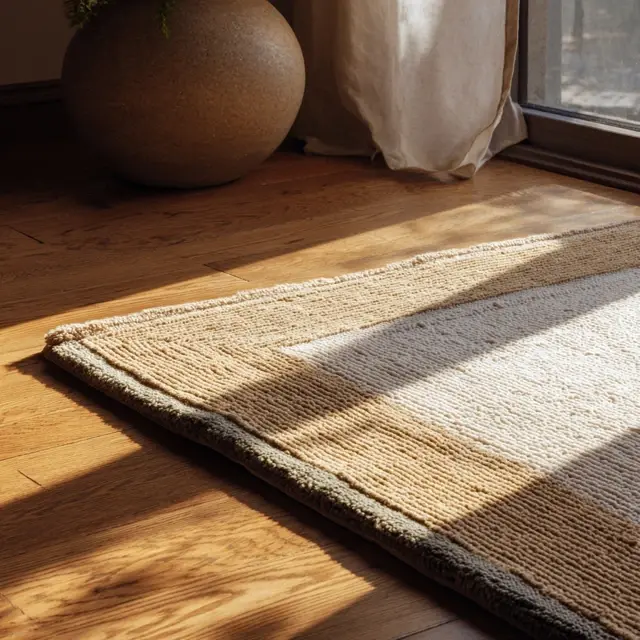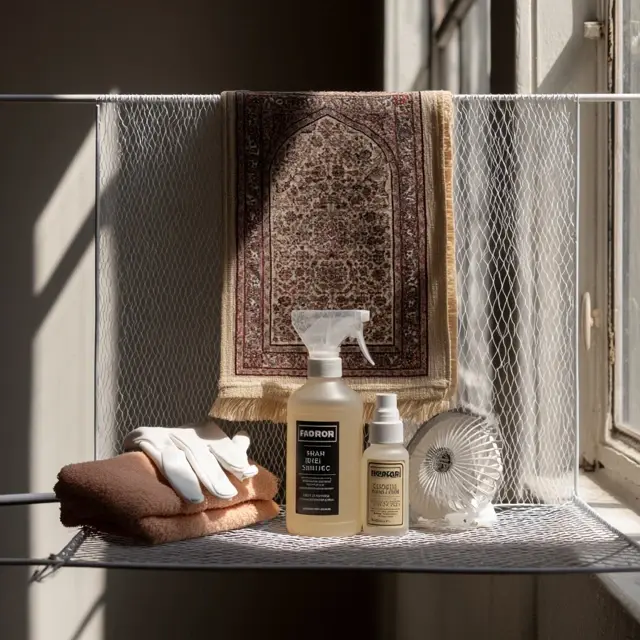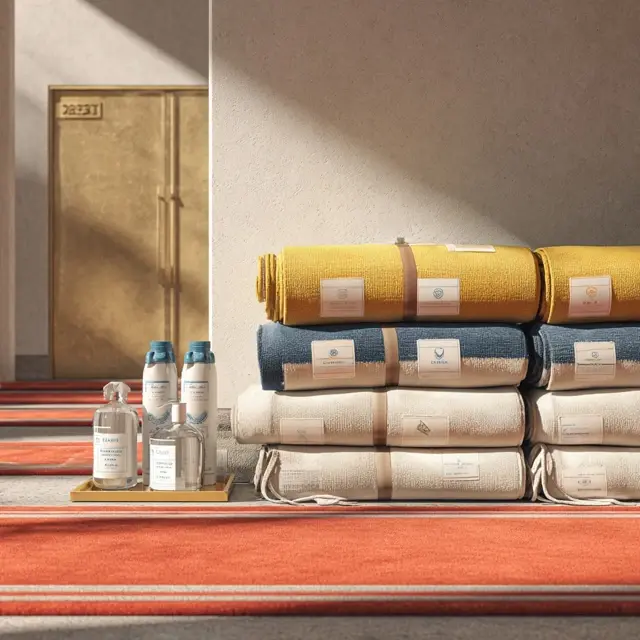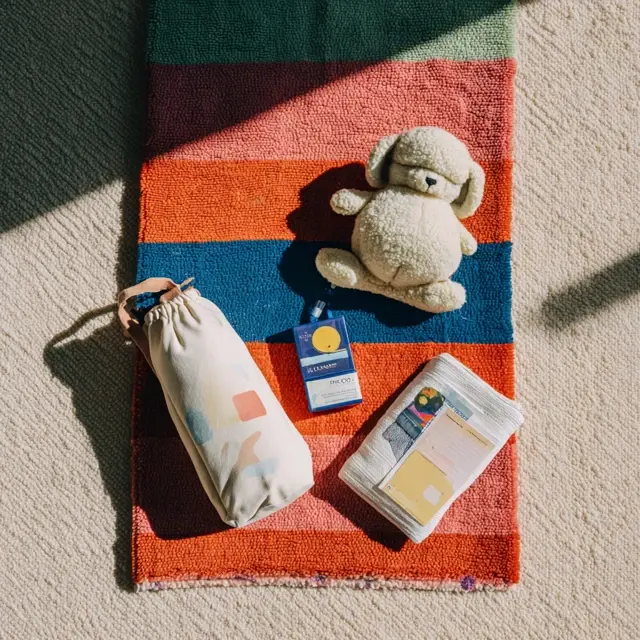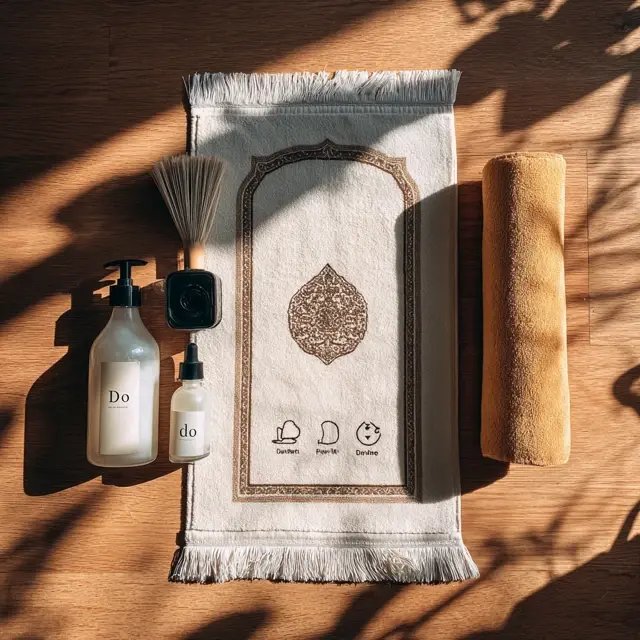Using Rug Pads to Protect Your Prayer Mat
Adding a rug pad under your prayer mat is a small upgrade with outsized benefits: better grip, extra cushioning for knees and ankles, improved airflow, and protection for both backing and floors. Here’s how to choose the right pad, trim it correctly, and maintain the set so it lasts.
Why Use a Rug Pad?
- No-slip stability: Keeps the mat from sliding on tile, laminate, or polished wood.
- Comfort boost: A thin cushion reduces pressure on joints during sujood and long sessions.
- Floor protection: Prevents dye transfer and micro-abrasion, especially on sensitive hardwood finishes.
- Mat longevity: Reduces edge wear and minimizes backing stress from daily movement.
- Airflow & hygiene: Slight elevation helps moisture evaporate, limiting stale odors.
Rug Pad Materials: Pros & Cons
Felt (100% Felt or Felt+Rubber Hybrid)
- Pros: Excellent cushioning; felt+rubber versions add grip.
- Cons: Pure felt can slide on smooth floors; choose hybrid if you need traction.
- Best for: Textile-backed cotton/poly prayer mats on wood or laminate.
Natural Rubber (Solid or Waffle)
- Pros: Strong non-slip performance; floor-finish friendly when quality is high.
- Cons: Low-quality blends can crumble; avoid synthetic fillers.
- Best for: Thin mats or printed faces where you want low profile + high grip.
TPR (Thermoplastic Rubber)
- Pros: Stable grip, often more heat/oxidation resistant than cheap latex.
- Cons: Some finishes can react; verify “floor-safe” claims and avoid high heat.
- Best for: Modern floors and mats with textile backs; patch test first.
Latex / PVC Mesh
- Pros: Common and inexpensive; decent grip on tile.
- Cons: Can off-gas, yellow floors, or stick with heat; choose premium, floor-rated products or avoid altogether on polyurethane-coated wood.
- Best for: Temporary setups on ceramic tile; not ideal for delicate finishes.
Choosing Thickness & Density
- Thin (1–2 mm): Maximum stability; good for thick, cushioned prayer mats.
- Medium (3–5 mm): Balanced comfort + grip; ideal for most households.
- Thick (6–9 mm felt): Extra cushion for joints; ensure edges don’t raise a trip hazard.
Compatibility with Prayer Mat Backings
- Textile back (cotton/poly): Compatible with felt, rubber, or TPR.
- Non-slip coated (latex/TPR): Use a floor-safe natural rubber or felt+rubber pad; avoid pad + mat made of the same coating to reduce sticking.
- Foam/cushioned core: Choose a thin pad to prevent a bouncy feel; ensure full drying after any cleaning before re-layering.
Floor Type Considerations
- Hardwood: Select natural rubber or hybrid felt+rubber marked floor-finish safe. Avoid cheap PVC/latex that can imprint or discolor.
- Laminate/Vinyl: Confirm pad compatibility with manufacturer guidance; TPR and some natural rubbers are safer than PVC.
- Tile/Stone: Grip-first pads (natural rubber or waffle TPR) perform best; thickness can be minimal.
- Carpet-over-carpet: Use a carpet-to-rug pad designed to anchor rugs over carpet without buckling.
How to Size & Trim a Rug Pad
- Measure the mat: Note width/length of your prayer mat.
- Subtract 1–2 inches (2.5–5 cm) from each dimension so the pad sits slightly inside—this hides edges and avoids trip points.
- Trim cleanly: Use sharp scissors or a utility knife with a straightedge for felt pads; aim for square corners.
- Test fit: Place the pad, then lay the mat. The mat should drape just beyond the pad on all sides.
Step-by-Step Setup
- Clean the floor: Vacuum/dust-mop so debris doesn’t telegraph through.
- Lay the pad flat: Texture down for rubber/TPR; smooth side up if specified by the brand.
- Layer the mat: Align the prayer mat with the pad’s center; smooth outward to remove air pockets.
- Edge check: Walk the perimeter and ensure zero pad exposure.
Care & Maintenance of the Pad
- Monthly lift: Air the pad and mat for 10–20 minutes; wipe the floor underneath.
- Spot clean: Wipe rubber/TPR with a damp cloth; vacuum felt pads with a brush tool.
- Heat awareness: Avoid radiant heat/hot floors with PVC/low-quality latex pads.
- Replace when: The pad becomes brittle, slick, or leaves residue.
Safety, Comfort & Performance Tips
- Low-profile wins: A thinner pad often provides enough grip without raising edges.
- Joint relief: For thin mats, choose a medium-firm felt+rubber so you gain cushion and stability.
- Humidity control: In damp climates, air the stack more frequently to keep both pad and mat dry.
Troubleshooting
- Mat still slips: Upgrade to natural rubber or a hybrid pad, or replace a worn pad that’s lost tack.
- Edges curl: Ensure the pad is smaller than the mat; reverse-roll mat edges for 10 minutes to relax curl.
- Residue on floor: Discontinue the pad, clean the floor per manufacturer guidance, and switch to a certified floor-safe material.
At-a-Glance Buying Checklist
- ☐ Floor-safe material (natural rubber or TPR; avoid cheap PVC)
- ☐ Thickness matched to your mat (thin or medium)
- ☐ Pad trimmed 1–2 inches smaller than mat
- ☐ Non-slip rating and warranty fit your floor type
- ☐ Easy to lift, air, and clean monthly
Suggested internal link anchors: “Prayer Mat Fabric Guide,” “Non-Slip Backing Care,” “Remove Stains from a Prayer Mat Without Damage.”
